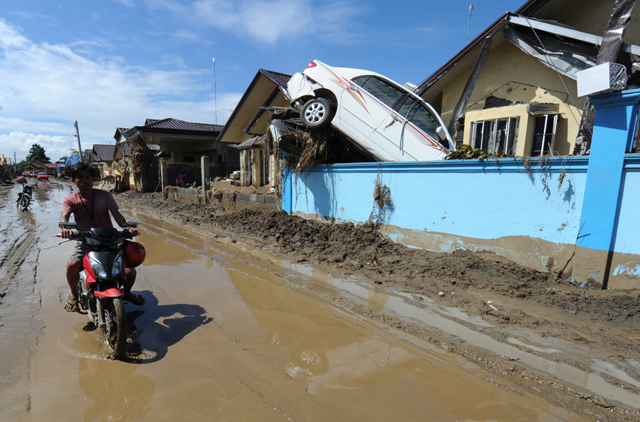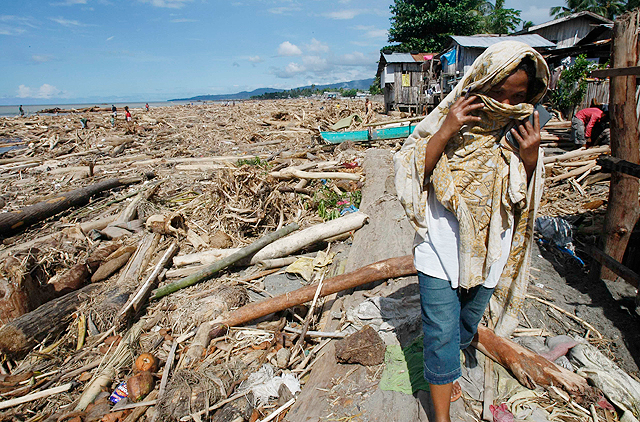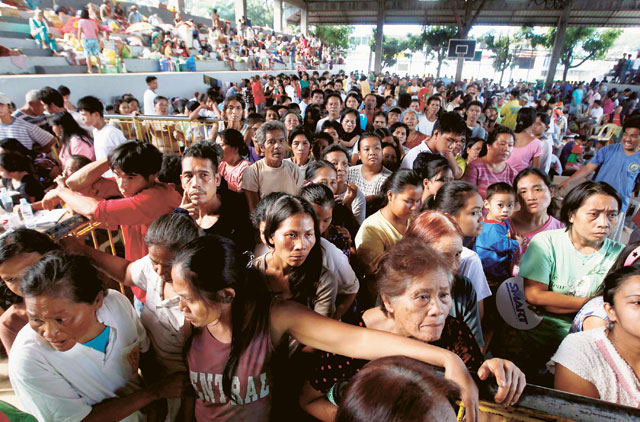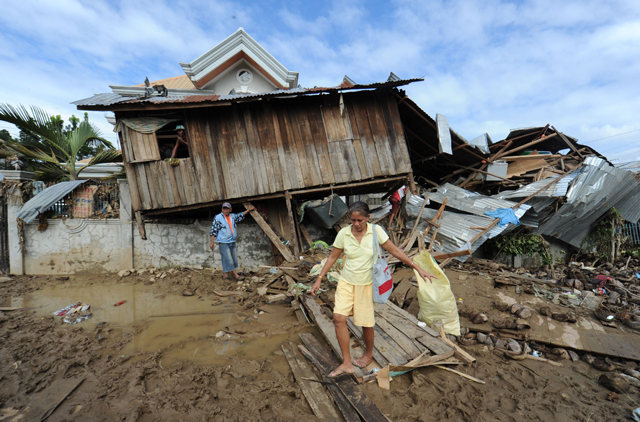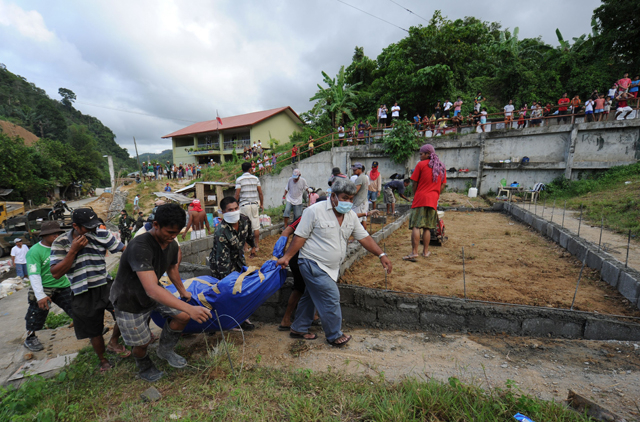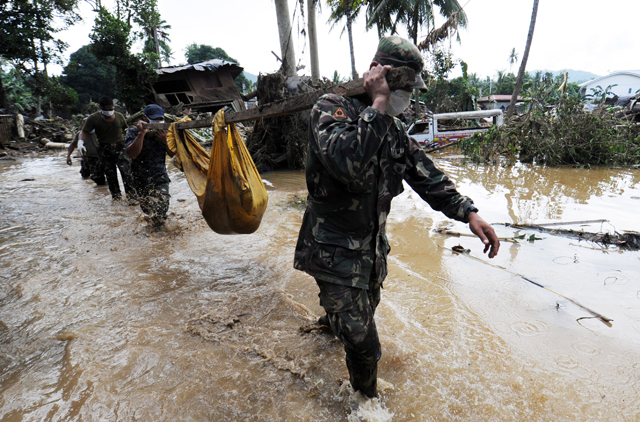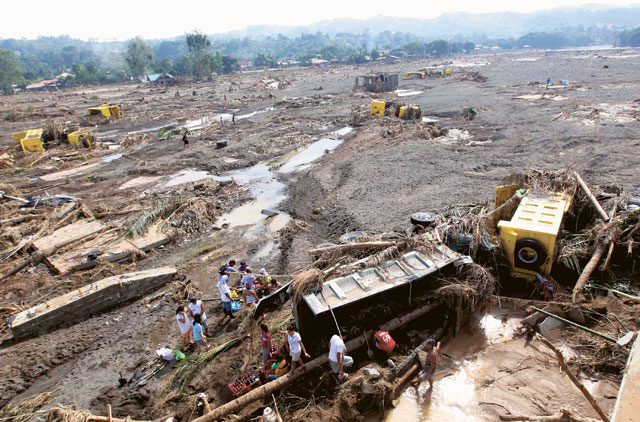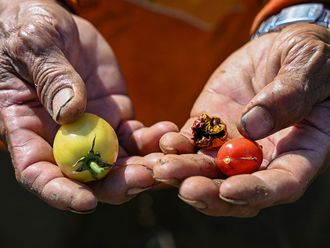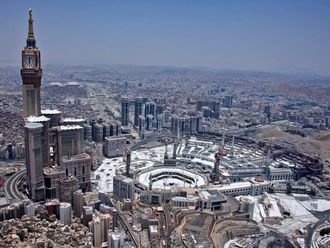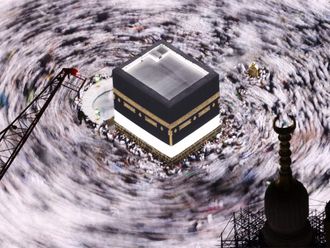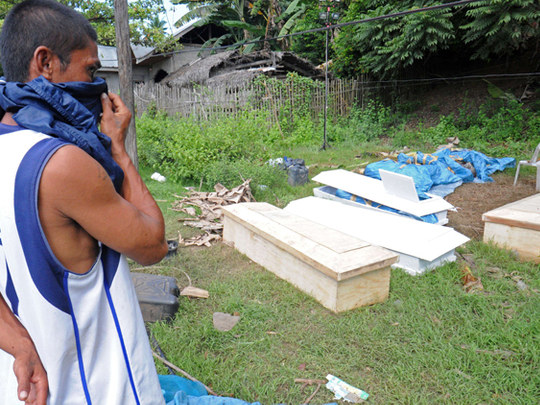
Iligan: The government shipped more than 400 coffins to two flood-stricken cities in the southern Philippines on Tuesday as the death toll neared 1,000 and President Benigno Aquino III declared a state of national calamity.
The latest count listed 957 dead and 49 missing and is expected to climb further as additional bodies are recovered from the sea and mud in Iligan and Cagayan de Oro cities.
A handful of morgues are overwhelmed and running out of coffins and formaldehyde for embalming. Aid workers appealed for bottled water, blankets, tents and clothes for many of 45,000 in crowded evacuation centres.
437 white, wooden coffins
Navy sailors in Manila loaded a ship with 437 white wooden coffins to help local authorities handle the staggering number of dead. Also on the way were containers with thousands of water bottles.
Most of the dead were women and children who drowned Friday night when flash floods triggered by a tropical storm gushed into homes while people were asleep.
Dozens of grieving relatives of at least 38 victims wept openly during funeral rites at the Iligan city cemetery. Many wore masks to try to block the stench of decomposing bodies.
"We have to give the dead a decent burial," Mayor Lawrence Cruz said. He said authorities were using part of the cemetery's passageway to build tombs.
National disaster
Cagayan De Oro: Philippines authorities on Tuesday began burying the dead from flash floods that have left more than 1,000 dead or missing, as President Benigno Aquino declared a national disaster.
Aquino flew to Mindanao island to inspect the ports of Cagayan de Oro and Iligan - choked with drying mud, crumpled homes, and hundreds of decomposing corpses after being struck by tropical storm Washi on the weekend.
Dump trucks
Two dump trucks arrived at the public cemetery in Iligan at dusk, with soldiers unloading 38 coffins of victims who have been identified and claimed by relatives, who cried and lit candles as they witnessed the burial.
On Monday as the stench of decomposing bodies grew unbearable and health fears rose, local authorities had announced plans for burials in mass graves but after intense criticism they hastily arranged individual tombs.
"It is not like digging a hole and sticking them in there. They are being given apartment-style compartments, and I think it's pretty decent," Iligan city Mayor Lawrence Cruz told AFP as he led the first of the burials.
Holy water
A priest sprinkled holy water on each coffin before it was pushed into the tombs.
Cruz said that forensics experts were taking fingerprints and DNA samples of the many other unidentified bodies at overflowing local mortuaries and that dozens more cadavers would be ready for burial on Wednesday.
Aquino pledged aid to the slum communities hit by the disaster, which the government has said left 957 people dead and 49 others missing - a toll they fear could rise as bodies swept out to sea begin to surface.
"I assure you the government will help you rebuild your homes. But in return we expect you to refrain from moving back to those places that put your lives at constant risk," Aquino said in a speech at an evacuation centre.
The president pledged to repair damaged roads and water systems, mass housing units in safe relocation areas, and water level sensors for all major river basins across the country to help communities avoid similar disasters.
National calamity
Mass burials had been put on hold while forensic procedures were being carried out, officials said.
The national disaster agency said 957 were killed and 49 were missing, with most of the casualties in the cities of Cagayan de Oro and Iligan in the Mindanao region. A British national was among those killed by the storm, Britain's Foreign Office said.
Most of the dead were from the port cities of Iligan and Cagayan de Oro, which were built around river systems that overflowed when a month's worth of rain fell in a 24 hour period at the weekend.
Aquino held meetings with officials in the two cities, worst-hit by flooding. "First priority is to relocate to areas that no longer pose a danger to them," Aquino said at a meeting with officials in Cagayan de Oro.
Relief, rehabilitation
Aquino's spokesman, Ricky Carandang, said the declaration of a national calamity would allow the government to access a bigger pool of funds for relief and rehabilitation.
He has also ordered an investigation into what went wrong and why so many people died. "I do not accept that everything had been done. I know that we can do more. We must determine what really happened," Aquino said. "Must this end in tragedy? We knew that [storm] was coming. There should have been efforts to avoid the destruction."
The disaster agency said more than 338,000 people in 13 provinces were affected by the disaster, with nearly 43,000 still in evacuation centres. Many schools, roads, and bridges and more than 10,000 houses were also damaged.
Individual tombs
A day after announcing mass burial plans for unclaimed bodies, the local governments of Iligan and nearby Cagayan de Oro said on Tuesday that the justice ministry had insisted on proper documentation as well as individual tombs.
They said the burials will now have to wait until small teams of government forensics experts finish documenting each cadaver, a tedious process performed at overflowing mortuaries and, in the case of Cagayan de Oro, near a landfill.
Morgues overwhelmed
On Monday, Philippine rescuers struggled against mud, fatigue and the stench of death to help the survivors of devastating flash floods, while flood-hit cities prepared to bury the dead in mass burial sites, slated to begin on Tuesday.
As bodies washed out to sea began surfacing, mortuaries were overwhelmed and emergency teams struggled to find survivors in thick mud around the major port cities of Cagayan de Oro and Iligan on Mindanao island.
Iligan Mayor Lawrence Cruz said on Monday that mass burial was necessary because of health concerns. Apart from the decomposing bodies, dead livestock lie scattered in the mud.
Non-government organisations and Philippine authorities raced to deliver help to areas in northeastern Mindanao that had been devastated by the Friday evening flashfloods.
Entire villages were swept away by floodwaters as residents, normally spared from tropical storms that devastate other parts of the Philippines every year, slept in the early hours of Saturday despite storm warnings.
Bodies rising to the surface
"I'm out here retrieving bodies that are starting to rise to the surface," Benito Ramos, head of the national disaster council, said over mobile phone from a rescue boat off Cagayan de Oro on Monday.
Among the items urgently needed are coffins and body bags, Ramos said. "It's overwhelming. We didn't expect these many dead," he said, adding that authorities were continuing to find bodies floating at sea.
Presidential spokesman Edwin Lacierda on Sunday said truckloads of relief goods are on the way to Cagayan de Oro City and to Iligan City as well as other areas affected by tropical storm Washi.
Relief packages
Lacierda said the mercy flight will be bringing in loads of bottled water together with the relief packages. Health authorities had been apprehensive that an epidemic could be developing as water sources had been contaminated by flood runoff and decomposing detritus from dead human and animals.
Lacierda said the supplies would be airlifted to the affected areas through the use of the air forces' lone functioning C-130 cargo plane.
Deputy presidential spokesperson Abigail Valte said that aside from Cagayan de Oro and Iligan Cities other areas severely affected by Washi such as Surigao del Sur and Zamboanga del Norte in Mindanao, as well as Negros and Panay islands in the Visayas, are being given attention by the social welfare department.
Holidays
Tragedy struck Friday evening as unexpected heavy rainfall brought in by Washi left large areas of Iligan and Cagayan de Oro cities under several metres of water. The calamity came just as Filipinos were preparing for the Christian holidays.
As people in other parts of the country were holding their annual Christmas parties and workplace get togethers, their compatriots in Northern and Eastern Mindanao as well as in Central Philippines, were coping with the floods and the mud that went along with it.
While the floodwater has subsided, many families still remained at the evacuation centres while they try to fix and clean their damaged homes.
With inputs from agencies


